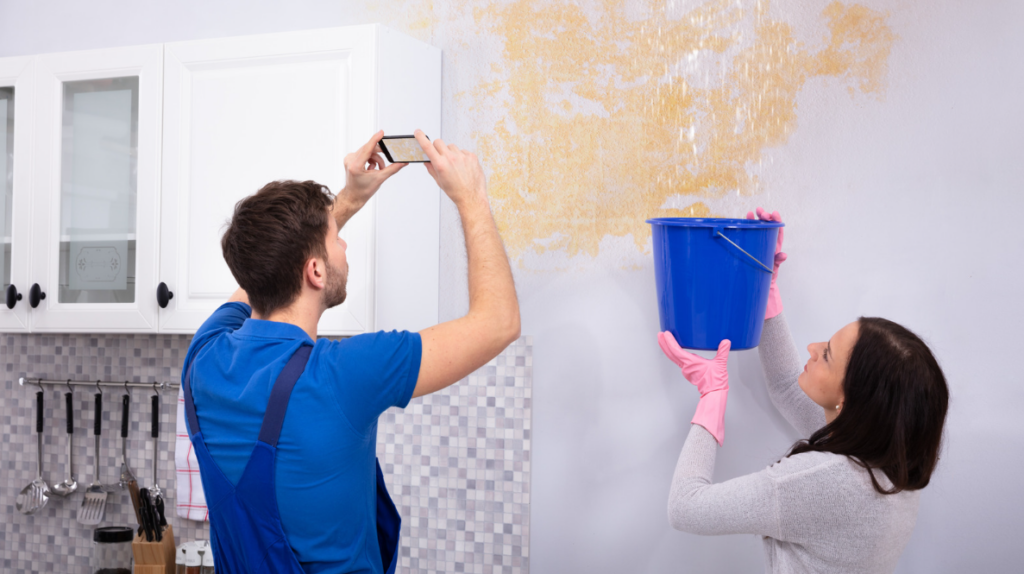Key Points:
- Understand the importance of documenting the damage thoroughly during the water damage claim process.
- Learn the specific steps to take when filing a water damage claim, including contacting your insurance company and mitigating further damage.
- Discover how working with a public adjuster can simplify and streamline your water damage claim.

Water damage is one of the most common and costly problems homeowners face. According to the Insurance Information Institute, water damage and freezing account for nearly 30% of all homeowners insurance claims.
From leaking pipes to severe storms, these events can cause serious damage to your property, and navigating the water damage claim process can often feel overwhelming. Fortunately, with the right steps, you can ensure that your claim is handled efficiently, and you’re fully compensated for your losses.
What Is the Water Damage Claim Process?
When dealing with water damage, understanding the claim process is crucial for homeowners. The water damage claim process is the series of steps you’ll follow to ensure your insurance company evaluates the damage to your property and determines the amount of compensation you’ll receive.
It’s important to note that the specifics of this process can vary depending on your insurance policy and the circumstances of the damage. However, the general steps remain fairly consistent across most insurance claims.
Step 1: Contact Your Insurance Company
Once the water damage occurs, your first step should always be to contact your insurance company. This allows you to report the claim officially and initiate the process. Many insurance policies require claims to be filed within a specific time frame, so you’ll want to act quickly.
When you contact your insurance company, make sure you have your policy number, details of the damage, and any photos or videos to help substantiate your claim. Be prepared to explain the extent of the water damage and answer any questions they may have.
Step 2: Prevent Further Damage
After you’ve reported the water damage, it’s essential to take immediate action to prevent further damage to your property. Insurance companies generally expect homeowners to mitigate damage, meaning you should do what you can to stop the situation from worsening.
This may involve shutting off the water supply, removing excess water with a wet vacuum, or placing tarps over leaky areas. The quicker you respond, the more likely your insurance company will honor your claim and ensure full reimbursement for the repairs.
If you’re unsure about the best way to prevent further damage, it’s often helpful to consult with a professional water damage restoration company.

Step 3: Document the Damage
Documenting the water damage thoroughly is essential for the success of your claim. Insurance adjusters will need as much detail as possible to assess the value of your claim, and well-documented evidence can make a significant difference in the outcome.
Here’s what to document:
- Take detailed photos and videos of the damage from various angles.
- List all damaged items, including furniture, appliances, and electronics.
- Record the date and time the damage occurred, as well as any actions you took to stop the damage from spreading.
- Keep receipts for any emergency repairs you made, as well as for any mitigation services.
Proper documentation gives your insurance company a clear understanding of the scope of the damage and can help avoid delays or disputes during the claims process.
Step 4: Meet With the Insurance Adjuster
After you file your claim, your insurance provider will send an adjuster to assess the damage. The adjuster’s job is to evaluate the extent of the water damage as well as estimate the cost of repairs.
It’s important to be present during this inspection. While the adjuster will conduct a thorough review, it’s beneficial to have your own records of the damage and any mitigation steps you took. If necessary, point out areas they might overlook or bring up any concerns about the damage you’ve noticed.
Step 5: Review the Settlement Offer
Once the insurance adjuster completes their assessment, they’ll send you a settlement offer based on their findings. This offer will include the amount they are willing to pay for repairs and any other costs associated with the water damage claim.
It’s essential to review this offer carefully. Sometimes, the amount offered may not cover all the repair costs, or there may be discrepancies with the damage that was assessed. If you feel that the settlement is too low or incomplete, you can dispute the offer and negotiate a higher amount.
Step 6: Make the Repairs
After you accept a settlement offer or come to a satisfactory agreement with your insurance company, it’s time to make the necessary repairs. Depending on your policy, you may be required to pay a deductible before the insurance payout is issued.
At this stage, you can begin restoring your home. This includes hiring contractors, purchasing materials, and completing any other repairs needed to return your property to its pre-damage state.
Step 7: Finalize the Claim
Once the repairs are complete, you’ll need to submit any final documentation to your insurance company. This can include receipts for repairs, invoices for contractors, and any other costs associated with restoring your home.
Your insurance company will process the final claim and issue any remaining payment owed to you, minus the deductible. Make sure to keep records of everything, including any communications with your insurer, in case any questions arise later.
How to Avoid Common Water Damage Claim Pitfalls
Water damage claims can be complicated, and many homeowners face challenges during the process. Here are a few common mistakes to avoid:
- Failure to document thoroughly: Without clear documentation, you may find it difficult to get the full compensation you’re entitled to.
- Waiting too long to file: Many insurance policies require claims to be filed promptly. Don’t delay, or you could risk losing coverage.
- Not understanding your policy: Some policies may have exclusions or specific clauses related to water damage, so it’s important to read and understand the terms before filing a claim.
By avoiding these pitfalls and following the correct procedures, you’ll have a better chance of receiving a fair payout for your water damage claim.

How Can a Public Adjuster Help in the Water Damage Claim Process?
Hiring a public adjuster can significantly benefit homeowners dealing with water damage. Public adjusters work on behalf of the homeowner, not the insurance company, and their role is to ensure you get the compensation you deserve.
A public adjuster can help in several ways:
- Maximize your payout: Public adjusters have experience negotiating with insurance companies and can ensure your settlement reflects the true extent of the damage.
- Handle paperwork and deadlines: They’ll take care of the administrative burden, ensuring that all necessary documents are submitted on time.
- Expert guidance: Public adjusters are familiar with insurance policies and the claims process, meaning they can help you avoid common mistakes.
If you recently have faced water damage, working with a public adjuster for water damage claims can give you peace of mind and ensure that your claim is handled professionally.
Get the Fair Settlement You Deserve—Contact Crestview Today!
If you’ve recently experienced water damage and need help navigating the claims process, Crestview is here for you. Our experienced public adjusters in NYC, NJ, and Florida specialize in managing water damage claims, ensuring that you receive the fair settlement you deserve. With years of expertise in the water damage claim process, Crestview helps homeowners make sure they aren’t shortchanged by their insurance providers.
Contact us today to learn how we can help you maximize your settlement and streamline your water damage claim process. We’ll handle the complexities, so you can focus on getting your home back to normal.

